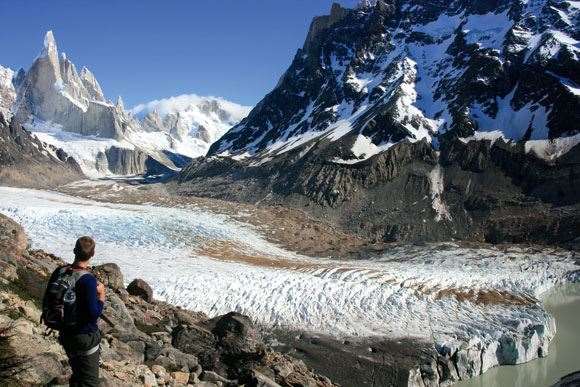When you’re climbing the crevasses of a Patagonian glacier the ice feels as permanent as the granite mountains overhead. But these glaciers are dying fast...
When you’re climbing the crevasses of a Patagonian glacier the ice feels as permanent as the granite mountains overhead. But these glaciers are dying fast...
 Argentina’s Los Glaciares Park is aptly named.
Argentina’s Los Glaciares Park is aptly named.Images: Hillary Stiel
Argentina’s Los Glaciares Park is aptly named. Almost a third of the park is covered by the Patagonic Ice Field, a vast blanket of ice eclipsed in size only by Antarctica and Greenland. Curling from this blanket of ice are 47 glaciers that then branch, like a fractured windshield, into any number of smaller glaciers. Everywhere you look, there’s another glacier – coiling around the foot of a mountain, poking through the opening of a valley, falling down the face of a cliff. And everywhere you look, these glaciers are retreating. The Upsala glacier, a 50km long river of ice, is retreating almost 220m a year, while the Viedma glacier, covering almost 1000 square kilometres, has retreated one and a half kilometres since the mid ’90s. So my goal is this: to clamber across a Patagonian glacier, to climb the walls of its crevasses, before the things disappear altogether.I emerge from the shade of the lenga forest to see the Grande glacier laid out beneath me. It looks impossibly large, a ragged carpet of ice. For most of the year this glacier is raked by a frozen, knifing wind the locals call “la escoba de Dios” – the broom of God. The strength of this wind is difficult to describe – walk into it and you have to adopt a gorilla lope, walk with it at your back and it sends you stumbling like a drunk. It’s a wind more than capable of flipping you over a ridge. But today the sun is fierce and God’s broom is still and the glacier below glitters a piercing blue-white.
The Grande is not the biggest glacier in the area. Compared to the monumental Viedma or Perito Moreno or Upsala – rivers of ice that surge straight out of the Patagonic Ice Field – the Grande is a relative minnow. But for a mountain glacier it’s an impressive sweep. It is, in fact, the confluence of three glaciers – the Grande, the Torre and the Adela – that tumble down the lower slopes of the Torre Range, then coil together to form a two kilometre-wide tongue of ice. At its tip, the Grande empties into the Laguna Torre, a three hectare oval of opaque water that bobs with truck-sized ice bergs. When God’s broom sweeps, this lake is torn into a boiling mess of white-caps that thunder against the bergs. Today it’s dead flat. On the northern shore of the lake rises Mount Fitz Roy, a three and a half kilometre-high knob of granite. To the east, behind the glacier, rises Cerro Torre (3107m), a fabulous needle of pink granite rimmed by drifts of snow and seams of ice. For a time this mountain, first ascended by a quartet of Italians in 1974, was considered the world’s toughest climb.
As we approached the Grande, hiking along a 15km valley of bouldered moraine, the glacier looked smooth and benign. But now we’re closer it takes a different form. At points where the glacier moves fastest – at its edges and steepest points – its skin has fractured. From the valley these points looked shaded and lightly cracked. Now we can see that the fractures are actually vast spines of ice that jut straight up, their razor edges glowing pale blue in the sun before disappearing into shadowy green crevasses gurgling with water. This is where we’re headed.
Related Articles

Socceroos coach says Argentina can only 'play two ways'

Argentina coach on 'inferior' Socceroos: 'I don't fully agree'













